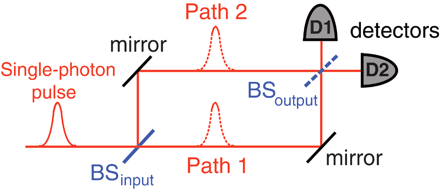
El experimento de Wheeler de elección retardada
o experimento del espejo semirreflector
![]() El experimento del espejo semirreflector es un bello experimento que fue concebido inicialmente como «gedanken experiment», un experimento conceptual, en el contexto del gran debate epistemológico que tuvo lugar entre Einstein y Bohr:
El experimento del espejo semirreflector es un bello experimento que fue concebido inicialmente como «gedanken experiment», un experimento conceptual, en el contexto del gran debate epistemológico que tuvo lugar entre Einstein y Bohr:
![]() N. Bohr, Discussion with Einstein on epistemological problems in Atomic Physics, en Schilpp, ed., Albert Einstein: Philosopher-Scientist, Library of Living Philosophers, Evanston, 1949, cit. por J.A. Wheeler en «The ‘Past’ and the ‘delayed-choice’ Double-Slit experiment», R.Marlow, ed., Mathematical Foundations of Quantum Theory, Academic, New York, 1978:
N. Bohr, Discussion with Einstein on epistemological problems in Atomic Physics, en Schilpp, ed., Albert Einstein: Philosopher-Scientist, Library of Living Philosophers, Evanston, 1949, cit. por J.A. Wheeler en «The ‘Past’ and the ‘delayed-choice’ Double-Slit experiment», R.Marlow, ed., Mathematical Foundations of Quantum Theory, Academic, New York, 1978:
![]() The extent to which renunciation of the visualization of atomic phenomena is imposed upon us by the impossibility of their subdivision is strikingly illustrated by the following example, to which Einstein very early called attention and often has reverted. If a semi-reflecting mirror is placed in the way of a photon, leaving two possibilities for its direction of propagation, the photon may either be recorded on one, and only one, of two photographic plates situated at great distances in the two directions in question, or else we may, by replacing the plates by mirrors, observe effects exhibiting an interference between the two reflected wave-trains. In any attempt of a pictorial representation of the behavior of the photon we would, thus, meet with the difficulty: to be obliged to say, on the one hand, that the photon always chooses one of the two ways and, on the other hand, that it behaves as if it had passed both ways. (…) It is just arguments of this kind which recall the impossibility of subdividing quantum phenomena and reveal the ambiguity in ascribing customary physical attributes to atomic objects. (…) It may also be added that it obviously can make no difference as regards observable effects obtainable by a definite experimental arrangement, whether our plans of constructing or handling the instruments are fixed beforehand or whether we prefer to postpone the completion of our planning until a later moment when the particle is already on its way from one instrument to another.
The extent to which renunciation of the visualization of atomic phenomena is imposed upon us by the impossibility of their subdivision is strikingly illustrated by the following example, to which Einstein very early called attention and often has reverted. If a semi-reflecting mirror is placed in the way of a photon, leaving two possibilities for its direction of propagation, the photon may either be recorded on one, and only one, of two photographic plates situated at great distances in the two directions in question, or else we may, by replacing the plates by mirrors, observe effects exhibiting an interference between the two reflected wave-trains. In any attempt of a pictorial representation of the behavior of the photon we would, thus, meet with the difficulty: to be obliged to say, on the one hand, that the photon always chooses one of the two ways and, on the other hand, that it behaves as if it had passed both ways. (…) It is just arguments of this kind which recall the impossibility of subdividing quantum phenomena and reveal the ambiguity in ascribing customary physical attributes to atomic objects. (…) It may also be added that it obviously can make no difference as regards observable effects obtainable by a definite experimental arrangement, whether our plans of constructing or handling the instruments are fixed beforehand or whether we prefer to postpone the completion of our planning until a later moment when the particle is already on its way from one instrument to another.
![]() Bohr anticipa que la elección entre medios complementarios de observación no necesita ser hecha hasta que el paso de la partícula por el aparato esté casi completado, o, digamos, hasta que el fotón haya elegido viajar por un camino o por los dos, de forma que ya no puede «cambiar su decisión».
Bohr anticipa que la elección entre medios complementarios de observación no necesita ser hecha hasta que el paso de la partícula por el aparato esté casi completado, o, digamos, hasta que el fotón haya elegido viajar por un camino o por los dos, de forma que ya no puede «cambiar su decisión».
![]() El experimento viene a ser una variante Mach-Zehnder del de la doble rendija y fue propuesto por J.A. Wheeler y desarrollado y discutido por otros autores en varios artículos:
El experimento viene a ser una variante Mach-Zehnder del de la doble rendija y fue propuesto por J.A. Wheeler y desarrollado y discutido por otros autores en varios artículos:
![]() J.A. Wheeler, (pdf) «Law without law«, en Quantum theory and Measurement, Wheeler, J.A. y Zurek, W.H., eds.; Princenton Univ. Press, Princenton, N. Y., 1984, pp. 182-213.
J.A. Wheeler, (pdf) «Law without law«, en Quantum theory and Measurement, Wheeler, J.A. y Zurek, W.H., eds.; Princenton Univ. Press, Princenton, N. Y., 1984, pp. 182-213.
![]() Wheeler, J.A.; «The `Past’ and the ‘delayed-choice’ Double-Slit experiment», en R.Marlow, ed., Mathematical Foundations of Quantum Theory, Academic, New York, 1978, pp. 9-48.
Wheeler, J.A.; «The `Past’ and the ‘delayed-choice’ Double-Slit experiment», en R.Marlow, ed., Mathematical Foundations of Quantum Theory, Academic, New York, 1978, pp. 9-48.
![]() C.O. Alley, O. Jakukowicz, C.A. Steggerda and W.C. Wickes; A delayed Random Choice Quantum Mechanical Experiment with Light Quanta; Kamefuchi et al eds., Proceedings of the International Symposium on the Foundations of Quantum Mechanics in the Light of New Technology, Tokyo, 1983; Physical Society of Japan, 1984, pp. 158-164.
C.O. Alley, O. Jakukowicz, C.A. Steggerda and W.C. Wickes; A delayed Random Choice Quantum Mechanical Experiment with Light Quanta; Kamefuchi et al eds., Proceedings of the International Symposium on the Foundations of Quantum Mechanics in the Light of New Technology, Tokyo, 1983; Physical Society of Japan, 1984, pp. 158-164.
Realización experimental
![]() Unos primeros experimentos pioneros:
Unos primeros experimentos pioneros:
![]() C.O. Alley, O. Jakukowicz, C.A. Steggerda and W.C. Wickes; «Results of the Delayed Random Choice Quantum Mechanics Experiment With Light Quanta and Proposal of a New Type of EPR Experiment Using Light Quanta Produced by a Nonlinear Optical Process»; Namiki et al. eds, Proceedings of the 2nd International Symposium: Foundations of Quantum Mechanics in the Light of New Technology, Tokyo, 1987; Physical Society of Japan, 1987, pp. 36-52. Una descripción resumida de este experimento puede encontrarse en el artículo de A. Shimony «The reality of Quantum World«, Scientific American 258 (1988)46, que apareció traducido en el número Temas 10, en 1997, de Investigación y Ciencia.
C.O. Alley, O. Jakukowicz, C.A. Steggerda and W.C. Wickes; «Results of the Delayed Random Choice Quantum Mechanics Experiment With Light Quanta and Proposal of a New Type of EPR Experiment Using Light Quanta Produced by a Nonlinear Optical Process»; Namiki et al. eds, Proceedings of the 2nd International Symposium: Foundations of Quantum Mechanics in the Light of New Technology, Tokyo, 1987; Physical Society of Japan, 1987, pp. 36-52. Una descripción resumida de este experimento puede encontrarse en el artículo de A. Shimony «The reality of Quantum World«, Scientific American 258 (1988)46, que apareció traducido en el número Temas 10, en 1997, de Investigación y Ciencia.
![]() W. Schleich, H. Walther; Single-Atom and SinglePhoton Experiments; Namiki et al.,ibid., pp. 25-35.
W. Schleich, H. Walther; Single-Atom and SinglePhoton Experiments; Namiki et al.,ibid., pp. 25-35.
![]() T. Hellmuth, H. Walther, A. Zajonc and W. Schleich, «Delayed-choice experiments in quantum interference», Physical Review A35-6 (1987)2532.
T. Hellmuth, H. Walther, A. Zajonc and W. Schleich, «Delayed-choice experiments in quantum interference», Physical Review A35-6 (1987)2532.
Realización experimental definitiva en 2007:![]()
![]() V. Jacques, E. Wu, F. Grosshans, F. Treussart, P. Grangier, A. Aspect, J.-F. Roch, Experimental Realization of Wheeler’s Delayed-Choice Gedanken Experiment, Science 315, 5814 (2007) 966-968, DOI: 10.1126/science.1136303.
V. Jacques, E. Wu, F. Grosshans, F. Treussart, P. Grangier, A. Aspect, J.-F. Roch, Experimental Realization of Wheeler’s Delayed-Choice Gedanken Experiment, Science 315, 5814 (2007) 966-968, DOI: 10.1126/science.1136303.
![]() El artículo en ArXiv.org: http://arxiv.org/abs/quant-ph/0610241v1: http://arxiv.org/pdf/quant-ph/0610241v1.pdf.
El artículo en ArXiv.org: http://arxiv.org/abs/quant-ph/0610241v1: http://arxiv.org/pdf/quant-ph/0610241v1.pdf.
![]() Planteamiento general inicial: sin elección retardada.
Planteamiento general inicial: sin elección retardada.
-Se lanza luz monofotónica sobre un interferómetro de Mach-Zehnder:
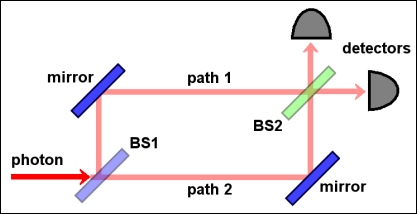
-La inclinación del segundo divisor de haz BS2 puede variarse, de manera que su acción equivale a la de un desfasador; además, su acción también puede anularse por completo (o sea: suprimirlo en el montaje), aplicándole un voltaje nulo, lo que equivale a tener sólo un divisor de haz: supresión de las interferencias.
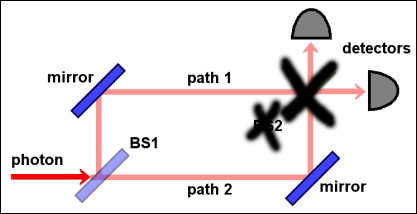
En el montaje con los dos divisores de haz presentes, variando el desfase
, se obtienen oscilaciones en las ratios de contaje de los dos detectores (gráfica A).
En el montaje con un solo divisor de haz (BS1) presente, no se producen oscilaciones en las ratios de contaje de los dos detectores: cada uno señala en el 50% de las ocasiones, y nunca en coincidencia (gráfica B).
Cuando se mantiene la acción del segundo BS, el montaje es equivalente a una doble rendija sin detección de camino: observación de interferencia (gráfica A), que se manifiesta en las oscilaciones de las ratios de contaje de los detectores.
Cuando se anula la acción del segundo BS, el montaje es equivalente a una doble rendija con detección de camino: no se produce interferencia (gráfica B)
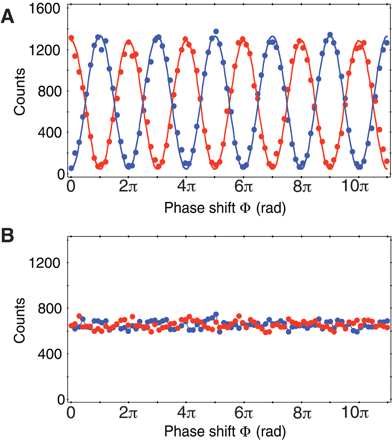
cuando no actúa el segundo BS (experimento con detección de camino), los dos detectores clickean con igual frecuencia (¡y nunca a la vez!): la configuración es análoga a la de una doble rendija con observación de camino: no hay proceso interferencial («conducta corpuscular»).
cuando el desfase se ajusta a los valores
y
, sólo da señal uno de los dos sendos detectores (ver el punto de divisores de haz): el experimento se muestra entonces como análogo a una doble rendija sin observación de camino: con proceso interferencial («conducta ondulatoria»).
![]() La doble rendija a la Mach-Zehnder
La doble rendija a la Mach-Zehnder
![]() Con segundo divisor de haz BS2: el fotón produce interferencia (dependiendo de la diferencia de fase entre los dos caminos, diferencia que se puede ajustar introduciendo un retardador en uno de los dos caminos); se puede conseguir, eligiendo el desfase adecuado entre los dos caminos ópticos, que siempre registre sólo uno y el mismo de los dos detectores, el detector-luz; el otro, el detector-oscuridad, no registra nunca (o bien, cualquier resultado intermedio con diferentes, o iguales, ratios de contaje en los dos detectores). Hay interferencia porque no hay determinación de camino (no which-way information).
Con segundo divisor de haz BS2: el fotón produce interferencia (dependiendo de la diferencia de fase entre los dos caminos, diferencia que se puede ajustar introduciendo un retardador en uno de los dos caminos); se puede conseguir, eligiendo el desfase adecuado entre los dos caminos ópticos, que siempre registre sólo uno y el mismo de los dos detectores, el detector-luz; el otro, el detector-oscuridad, no registra nunca (o bien, cualquier resultado intermedio con diferentes, o iguales, ratios de contaje en los dos detectores). Hay interferencia porque no hay determinación de camino (no which-way information).

Hay interferencia porque hay indistinguibilidad de caminos.
![]() Sin segundo divisor de haz BS2: el fotón alcanza aleatoriamente uno u otro detector (nunca los dos a la vez): hay determinación de camino (which-way information); con esta configuración, no se observan interferencias (esto es, oscilaciones en las ratios de contaje).
Sin segundo divisor de haz BS2: el fotón alcanza aleatoriamente uno u otro detector (nunca los dos a la vez): hay determinación de camino (which-way information); con esta configuración, no se observan interferencias (esto es, oscilaciones en las ratios de contaje).

No hay interferencia porque los dos caminos son distinguibles.

http://www.sciencemag.org/content/315/5814/966/F1.expansion.html
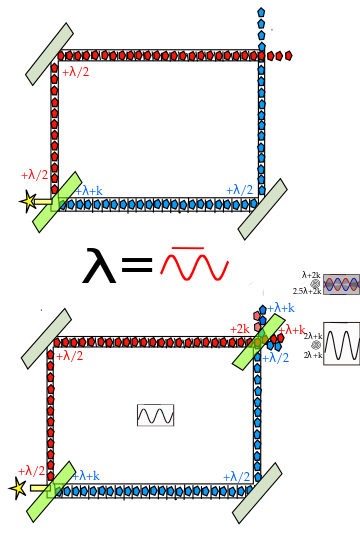
Experimento con elección retardada
![]() ¿Y si no decidimos qué tipo de experimento vamos a realizar, con o sin segundo divisor presente, hasta después de que el fotón ya haya entrado en el interferómetro, o sea, atravesado BS1?
¿Y si no decidimos qué tipo de experimento vamos a realizar, con o sin segundo divisor presente, hasta después de que el fotón ya haya entrado en el interferómetro, o sea, atravesado BS1?
…In a loose way of speaking, we decide what the photon shall have done after it has already done it. In actuality it is wrong to talk of the ‘route’ of the photon… (cf. Wheeler).
![]() Realizar un experimento de interferencia con fotones individuales en el que la elección de cuál propiedad será observada [partícula-una ruta, onda-dos rutas] se hace después de que el fotón ha atravesado un divisor de haz:
Realizar un experimento de interferencia con fotones individuales en el que la elección de cuál propiedad será observada [partícula-una ruta, onda-dos rutas] se hace después de que el fotón ha atravesado un divisor de haz:
![]() V. Jacques, E. Wu, F. Grosshans, F. Treussart, P. Grangier, A. Aspect and J.-F. Roch, Experimental Realization of Wheeler’s Delayed-Choice Gedanken Experiment, Science 315, 5814 (2007) 966-968, DOI: 10.1126/science.1136303.
V. Jacques, E. Wu, F. Grosshans, F. Treussart, P. Grangier, A. Aspect and J.-F. Roch, Experimental Realization of Wheeler’s Delayed-Choice Gedanken Experiment, Science 315, 5814 (2007) 966-968, DOI: 10.1126/science.1136303.
![]() Abstract: Wave-particle duality is strikingly illustrated by Wheeler’s delayed-choice gedanken experiment, where the configuration of a two-path interferometer is chosen after a single-photon pulse has entered it: Either the interferometer is closed (that is, the two paths are recombined) and the interference is observed, or the interferometer remains open and the path followed by the photon is measured. We report an almost ideal realization of that gedanken experiment with single photons allowing unambiguous which-way measurements. The choice between open and close configurations, made by a quantum random number generator, is relativistically separated from the entry of the photon into the interferometer.
Abstract: Wave-particle duality is strikingly illustrated by Wheeler’s delayed-choice gedanken experiment, where the configuration of a two-path interferometer is chosen after a single-photon pulse has entered it: Either the interferometer is closed (that is, the two paths are recombined) and the interference is observed, or the interferometer remains open and the path followed by the photon is measured. We report an almost ideal realization of that gedanken experiment with single photons allowing unambiguous which-way measurements. The choice between open and close configurations, made by a quantum random number generator, is relativistically separated from the entry of the photon into the interferometer.
![]()
The delayed-choice scheme is implemented as follows. Linearly polarized single photons are sent by a polarization beamsplitter BSinput through an interferometer (length 48 m) with two spatially separated paths associated with orthogonal S and P polarizations (Fig. 2). The movable output beamsplitter BSoutput consists of the combination of a half-wave plate, a polarization beamsplitter BS′, an electro-optical modulator (EOM) with its optical axis oriented at 22.5° from input polarizations, and a Wollaston prism. The two beams of the interferometer, which are spatially separated and orthogonally polarized, are first overlapped by BS′ but can still be unambiguously identified by their polarization. Then, the choice between the two interferometer configurations, closed or open, is realized with the EOM, which can be switched between two different configurations within 40 ns by means of a homebuilt fast driver: Either no voltage is applied to the EOM, or its half-wave voltage Vπ is applied to it. In the first case, the situation corresponds to the removal of BSoutput and the two paths remain uncombined (open configuration). Because the original S and P polarizations of the two paths are oriented along prism polarization eigenstates, each “click” of one detector D1 or D2 placed on the output ports is associated with a specific path (path 1 or path 2, respectively). When the Vπ voltage is applied, the EOM is equivalent to a half-wave plate that rotates the input polarizations by an angle of 45°. The prism then recombines the two rotated polarizations that have traveled along different optical paths, and interference appears on the two output ports. We then have the closed interferometer configuration.
![]() ¡¿Dos caminos o uno?! ¡¿cambiar el pasado?!
¡¿Dos caminos o uno?! ¡¿cambiar el pasado?!
Mejor: cambiar el lenguaje:
«cambiar el relato del pasado inobservado«
Cambiar en el presente nuestro relato del pasado
![]() Los resultados del experimento concuerdan con la M.C., indicando definitivamente que no es posible especificar una trayectoria espacio-temporal a un fotón desde que penetra en el montaje hasta que es detectado por uno de los fotomultiplicadores dispuestos a su salida.
Los resultados del experimento concuerdan con la M.C., indicando definitivamente que no es posible especificar una trayectoria espacio-temporal a un fotón desde que penetra en el montaje hasta que es detectado por uno de los fotomultiplicadores dispuestos a su salida.
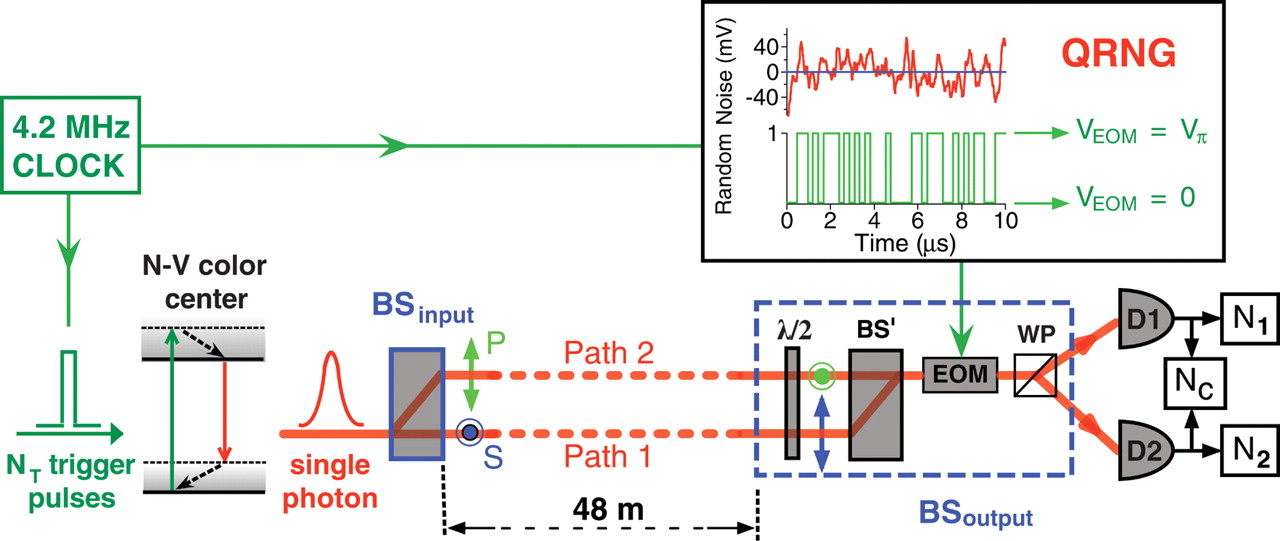
![]() Referencias básicas:
Referencias básicas:
![]() http://www.sciencemag.org/content/315/5814/966.full
http://www.sciencemag.org/content/315/5814/966.full
![]() http://physicsworld.com: cws/article/news/2007/feb /15/photons-denied-a-glimpse-of-their-observer
http://physicsworld.com: cws/article/news/2007/feb /15/photons-denied-a-glimpse-of-their-observer
![]() Este fenómeno fue descrito por Wheeler con la imagen de un «gran dragón de humo» con una cola bien definida, el fotón en el divisor de haz que le da entrada al aparato, y otro punto igualmente bien determinado, la boca del dragón, situada en el detector que registra al fotón a a su salida.
Este fenómeno fue descrito por Wheeler con la imagen de un «gran dragón de humo» con una cola bien definida, el fotón en el divisor de haz que le da entrada al aparato, y otro punto igualmente bien determinado, la boca del dragón, situada en el detector que registra al fotón a a su salida.
![]() Entre esos dos puntos, una «nube de humo» (silencio epistemológico) es sugerida como la representación correcta:
Entre esos dos puntos, una «nube de humo» (silencio epistemológico) es sugerida como la representación correcta:
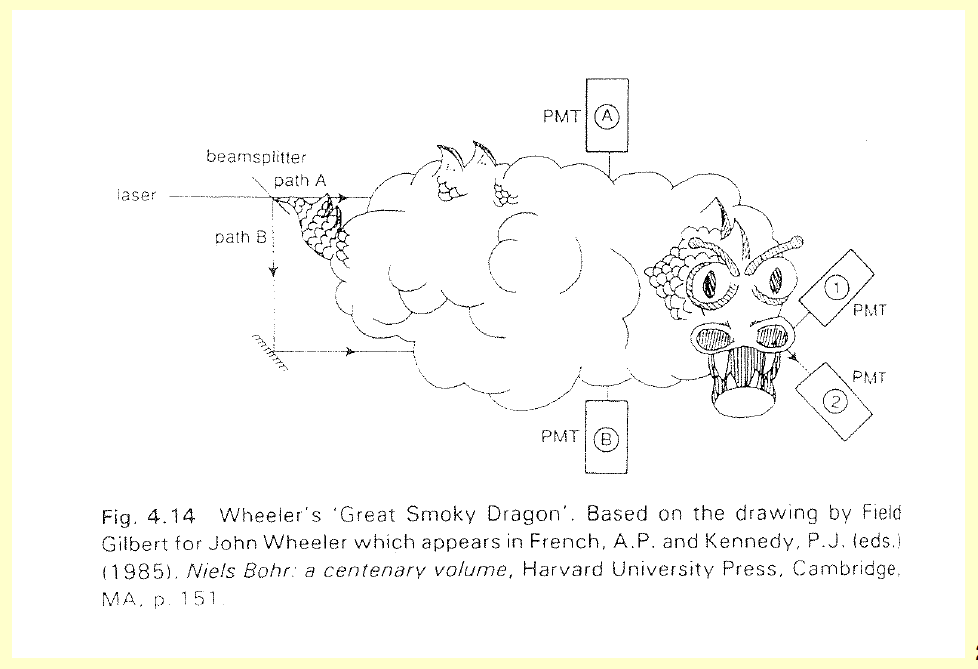
Entre la entrada al interferómetro y la detección, por enmedio, no ha lugar a hablar sobre lo que ocurre…
![]() Otra famosa frase de Wheeler resume la situación:
Otra famosa frase de Wheeler resume la situación:
J.A. Wheeler en ![]() The American Philosophical Society and The Royal Society: papers read at a meeting, June 5, American Philosophical Society, Philadelphia):
The American Philosophical Society and The Royal Society: papers read at a meeting, June 5, American Philosophical Society, Philadelphia):
![]() «No elementary phenomenon is a phenomenon until it is a registered (observed) phenomenon».
«No elementary phenomenon is a phenomenon until it is a registered (observed) phenomenon».
![]() Actualización: Wheeler’s delayed-choice gedanken experiment with a single atom:
Actualización: Wheeler’s delayed-choice gedanken experiment with a single atom:
![]() http://www.nature.com: /nphys/journal/vaop/ncurrent/full/nphys3343.html:
http://www.nature.com: /nphys/journal/vaop/ncurrent/full/nphys3343.html:
![]() Abstract: The wave–particle dual nature of light and matter and the fact that the choice of measurement determines which one of these two seemingly incompatible behaviours we observe are examples of the counterintuitive features of quantum mechanics. They are illustrated by Wheeler’s famous ‘delayed choice’ experiment, recently demonstrated in a single-photon experiment. Here, we use a single ultracold metastable helium atom in a Mach–Zehnder interferometer to create an atomic analogue of Wheeler’s original proposal. Our experiment confirms Bohr’s view that it does not make sense to ascribe the wave or particle behaviour to a massive particle before the measurement takes place. This result is encouraging for current work towards entanglement and Bell’s theorem tests in macroscopic systems of massive particles.
Abstract: The wave–particle dual nature of light and matter and the fact that the choice of measurement determines which one of these two seemingly incompatible behaviours we observe are examples of the counterintuitive features of quantum mechanics. They are illustrated by Wheeler’s famous ‘delayed choice’ experiment, recently demonstrated in a single-photon experiment. Here, we use a single ultracold metastable helium atom in a Mach–Zehnder interferometer to create an atomic analogue of Wheeler’s original proposal. Our experiment confirms Bohr’s view that it does not make sense to ascribe the wave or particle behaviour to a massive particle before the measurement takes place. This result is encouraging for current work towards entanglement and Bell’s theorem tests in macroscopic systems of massive particles.
Otros experimentos (borrado y elección retardada)
![]() 2012: http://www.scientificamerican.com/article/quantum-delayed-choice/
2012: http://www.scientificamerican.com/article/quantum-delayed-choice/
![]() Yoon-Ho Kim, R. Yu, S.P. Kulik, Y.H. Shih and Marlon O. Scully, A Delayed Choice Quantum Eraser; Phys.Rev.Lett. 84 1-5 (2000) 1-5; el artículo en quant-ph:https://doi.org/10.48550/arXiv.quant-ph/9903047.
Yoon-Ho Kim, R. Yu, S.P. Kulik, Y.H. Shih and Marlon O. Scully, A Delayed Choice Quantum Eraser; Phys.Rev.Lett. 84 1-5 (2000) 1-5; el artículo en quant-ph:https://doi.org/10.48550/arXiv.quant-ph/9903047.
![]() B.-G. Englert, Quantum erasure in double-slit interferometers with which-way detectors, American Journal of Physics 67, 325 (1999); https://doi.org/10.1119/1.19257.
B.-G. Englert, Quantum erasure in double-slit interferometers with which-way detectors, American Journal of Physics 67, 325 (1999); https://doi.org/10.1119/1.19257.
![]() Propuesto en 1991, el experimento ESW (cavidades micromáseres) al parecer no ha sido todavía realizado; sin embargo, otros dispositivos con el mismo propósito sí han sido ya implementados, en el contexto del denominado borrado cuántico:
Propuesto en 1991, el experimento ESW (cavidades micromáseres) al parecer no ha sido todavía realizado; sin embargo, otros dispositivos con el mismo propósito sí han sido ya implementados, en el contexto del denominado borrado cuántico:
![]() S. P. Walborn et al; Borrado cuántico; Investigación y Ciencia, febrero 2004.
S. P. Walborn et al; Borrado cuántico; Investigación y Ciencia, febrero 2004.
![]() S. P. Walborn et al; A double-slit quantum eraser; ArXiv.
S. P. Walborn et al; A double-slit quantum eraser; ArXiv.
![]() Divulgación:
Divulgación:
![]() A. Shimony, «The reality of Quantum World«, Scientific American 258 (1988)46.
A. Shimony, «The reality of Quantum World«, Scientific American 258 (1988)46.
![]() http://www.scientificamerican.com/article/slide-show-do-it-yourself-diy-quantum-eraser/
http://www.scientificamerican.com/article/slide-show-do-it-yourself-diy-quantum-eraser/
![]() Borrado cuántico sin conexión causal:
Borrado cuántico sin conexión causal:
![]() http://www.pnas.org/content/110/4/1221.abstract
http://www.pnas.org/content/110/4/1221.abstract
![]() http://www.investigacionyciencia.es/noticias/borrado-cuntico-sin-conexin-causal-10835
http://www.investigacionyciencia.es/noticias/borrado-cuntico-sin-conexin-causal-10835
Dejar una contestacion